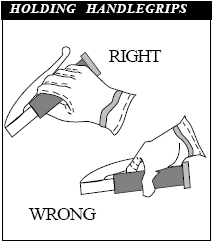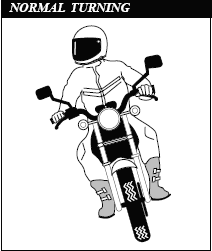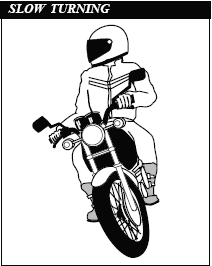Florida Motorcycle Handbook: Basic Vehicle Control
5. Ride within your Abilities
- 5.1. Basic Vehicle Control
- 5.6. Keeping your Distance
- 5.7. Lane Positions
- 5.8. Following Another Vehicle
- 5.9. Being Followed
- 5.10. Passing and Being Passed
- 5.11. Lane Sharing
- 5.12. Merging Cars
- 5.13. Cars Alongside
- 5.14. S.E.E.
- 5.15. Increasing Rider Visibility
- 5.16. Crash Avoidance
- 5.17. Handling Dangerous Surfaces
- 5.18. Mechanical Problems
- 5.19. Unavoidable Hazards
- 5.20. Getting Off the Road
- 5.21. Carrying Passengers and Cargo
- 5.22. Group Riding
- 5.23. Riding While Impaired
5.5.1 - BODY POSITION
To control a motorcycle well:
- Posture - Sit so you can use your arms to steer the motorcycle rather than to hold yourself up.
- Seat - Sit far enough forward so that arms are slightly bent when you hold the handlegrips. Bending your arms permits you to press on the handlebars without having to stretch.
- Hands - Hold the handlegrips firmly to keep your grip over rough surfaces. Start with your right wrist flat. This will help you keep from accidentally using too much throttle. Also, adjust the handlebars so your hands are even with or below your elbows. This permits you to use the proper muscles for precision steering.
- Knees - Keep your knees against the gas tank to help you keep your balance as the motorcycle turns.
- Feet - Keep your feet firmly on the footpegs to maintain balance. Don't drag your feet. If your foot catches on something, you could be injured and it could affect your control of the motorcycle. Keep your feet near the controls so you can get to them fast if needed. Also, don't let your toes point downward - they may get caught between the road and the footpegs.
5.5.2 - SHIFTING GEARS

There is more to shifting gears than simply getting the motorcycle to pick up speed smoothly. Learning to use the gears when downshifting, turning or starting on hills is important for safe motorcycle operation. Shift down through the gears with the clutch as you slow or stop. Remain in first gear while you are stopped so that you can move out quickly if you need to. Make certain you are riding slowly enough when you shift into a lower gear. If not, the motorcycle will lurch, and the rear wheel may skid. When riding downhill or shifting into first gear you may need to use the brakes to slow enough before downshifting safely. Work toward a smooth, even clutch release, especially when downshifting. It is best to change gears before entering a turn. However, sometimes shifting while in the turn is necessary. If so, remember to do so smoothly. A sudden change in power to the rear wheel can cause a skid.
5.5.3 - BRAKING
Your motorcycle has two brakes: one each for the front and rear wheel. Use both of them at the same time. The front brake is more powerful and can provide at least three-quarters of your total stopping power. The front brake is safe to use if you use it properly.
Remember:
- Use both brakes every time you slow or stop. Using both brakes for even "normal" stops will permit you to develop the proper habit or skill of using both brakes properly in an emergency. Squeeze the front brake and press down on the rear. Grabbing at the front brake or jamming down on the rear can cause the brakes to lock, resulting in control problems.
- If you know the technique, using both brakes in a turn is possible, although it should be done very carefully. When leaning the motorcycle some of the traction is used for cornering. Less traction is available for stopping. A skid can occur if you apply too much brake. Also, using the front brake incorrectly on a slippery surface may be hazardous. Use caution and squeeze the brake lever, never grab.
- Some motorcycles have integrated braking systems that link the front and rear brakes together by applying the rear brake pedal. (Consult the owner's manual for a detailed explanation on the operation and effective use of these systems.)
5.5.4 - TURNING
Riders often try to take curves or turns too fast. When they can't hold the turn, they end up crossing into another lane of traffic or going off the road. Or, they overreact and brake too hard, causing a skid and loss of control. Approach turns and curves with caution.
- SLOW
- LOOK
- PRESS
- ROLL
SLOW - Reduce speed before the turn by closing the throttle and, if necessary, applying both brakes.
LOOK - Look through the turn to where you want to go. Turn just your head, not your shoulders, and keep your eyes level with the horizon.
PRESS - To turn, the motorcycle must lean. To lean the motorcycle, press on the handlegrip in the direction of the turn. Press left - lean left - go left. Press right - lean right - go right. Higher speeds and/or tighter turns require the motorcycle to lean more.
ROLL - Roll on the throttle through the turn to stabilize suspension. Maintain steady speed or accelerate gradually through the turn. This will help keep the motorcycle stable.
| In normal turns, the rider and the motorcycle should lean together at the same angle. |
In slow tight turns, counterbalance by leaning the motorcycle only and keeping your body straight. |
 |
 |
Check out our Customer Reviews!


